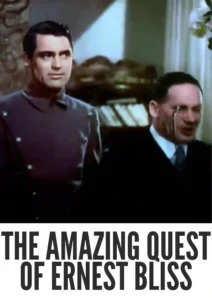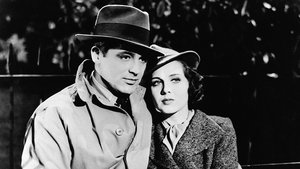Video Sources 0 Views
- The Amazing Quest of Ernest Bliss 1936 Colorized


Synopsis
Table of Contents
ToggleFrom Riches to Rags: The Amazing Quest of Ernest Bliss (1936) in Vibrant Color

Step back in time with The Amazing Quest of Ernest Bliss, a delightful romantic comedy from 1936, now beautifully colorized for a fresh viewing experience. Also known as Romance and Riches, this film stars Cary Grant as a wealthy man who bets he can earn his own living for a year. Perfect for fans of classic comedies and those who appreciate a heartwarming tale, this HD download offers a charming escape into a bygone era of cinema.
The Amazing Quest of Ernest Bliss Storyline: A Wager of Wealth
The Amazing Quest of Ernest Bliss tells the story of Ernest Bliss (Cary Grant), a wealthy and idle bachelor who believes money can buy happiness. Challenged by his doctor, Sir James Alroyd (Henry Kendall), Ernest makes a wager that he can live successfully for a year on his own earnings, without relying on his inherited wealth.Ernest embarks on a journey of self-discovery, taking on various jobs and experiencing the challenges and rewards of ordinary life. Along the way, he meets Frances Clayton (Mary Brian), a kind-hearted shop girl who captures his heart and teaches him the true value of hard work and genuine human connection. As Ernest navigates the ups and downs of his quest, he learns valuable lessons about life, love, and the importance of helping others. The Amazing Quest of Ernest Bliss is a feel-good story that reminds us that true wealth lies not in money, but in the richness of human experience.
Movie Cast
The film features a stellar cast that brings this heartwarming story to life:
- Cary Grant as Ernest Bliss
- Mary Brian as Frances Clayton
- Henry Kendall as Sir James Alroyd
- Peter Gawthorne as Mr. Montague
Movie Genre
The Amazing Quest of Ernest Bliss is a romantic comedy with elements of screwball and feel-good genres, characteristic of the era’s light-hearted and optimistic filmmaking.
Historical Context: Transatlantic Production
Released in 1936, The Amazing Quest of Ernest Bliss is a British film that features Cary Grant in one of his early roles. The film was produced during a time when British cinema was gaining more international attention, and it showcases the talents of both British and American actors. This film provides an interesting glimpse into the cinematic landscape of the 1930s and the evolving styles of filmmaking.
Colorization Details
This colorized version of The Amazing Quest of Ernest Bliss has been meticulously restored using modern digital techniques, enhancing the visual appeal while preserving the film’s original charm. The colorization process involved carefully analyzing the grayscale tones of the original black and white footage and assigning appropriate colors to each scene. While the specific software used remains proprietary, the techniques employed included advanced algorithms for color palette selection and image enhancement. This painstaking process brings new life to the characters and settings, making the story even more engaging for modern audiences. While some may debate the merits of colorizing classic films, it introduces these films to a broader audience, ensuring their legacy for future generations.
Technical Details
- Director: Alfred Zeisler
- Screenplay: John L. Balderston, Edwin Justus Mayer, Dorothy Green, Frank Vreeland
- Based on: the novel “The Amazing Quest of Ernest Bliss” by E. Phillips Oppenheim
- Cinematography: Günther Krampf
- Edited by: Ralph Kemplen
- Production Company: Paramount British Pictures
- Distributed by: Paramount British Pictures
- Runtime: 80 minutes
Technical Specifications
- Download Format: MP4
- Resolution: HD (1080p)
- Compatibility: Compatible with most devices, including smartphones, tablets, computers, and smart TVs.
Reviews and Critical Reception
The Amazing Quest of Ernest Bliss (1936) is celebrated for its light-hearted story, charming performances, and feel-good message. The film offers a delightful escape into a world of romance and optimism, making it a beloved classic for audiences of all ages. As a heartwarming tale with a touch of screwball comedy, The Amazing Quest of Ernest Bliss provides a unique perspective on the cinematic trends of the 1930s.
FAQs
- Q: What is The Amazing Quest of Ernest Bliss about?
- A: The Amazing Quest of Ernest Bliss is a romantic comedy about a wealthy man who makes a bet that he can earn his own living for a year.
- Q: Is The Amazing Quest of Ernest Bliss (1936) a well-known Cary Grant film?
- A: While not as widely known as some of his other films, The Amazing Quest of Ernest Bliss is a charming and enjoyable early role for Cary Grant.
- Q: Is this version of The Amazing Quest of Ernest Bliss colorized?
- A: Yes, this version has been professionally colorized to enhance the viewing experience.
- Q: What makes The Amazing Quest of Ernest Bliss interesting for classic film fans?
- A: The Amazing Quest of Ernest Bliss offers a delightful glimpse into the romantic comedies of the 1930s, with a heartwarming story and charming performances.
- Q: What is the download format?
- A: The download format is MP4, which is compatible with most devices.
- Q: What resolution is the download?
- A: The resolution is HD (1080p), providing a high-quality viewing experience.
Download Now in HD!
Watch The Amazing Quest of Ernest Bliss Today!










